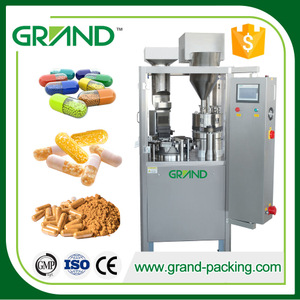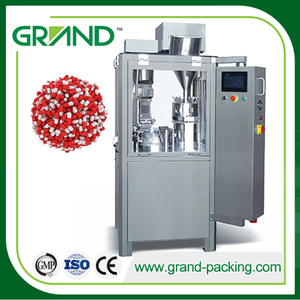Recently, most of filling machinery and packing machinery are equipped with automatic control function (PLC), which greatly improve production efficiency. However, the electrical automation machinery may be interfered by some factors, such as electrostatic interference, magnetic field coupling interference, common impedance interference, electromagnetic radiation interference, etc., causing the machinery cannot be started. Therefore, installation, operation and maintenance professionals must complete the anti-interference work during machinery production, deployment and operation, to avoid effecting the machinery performance.
Now, based on our years of experience in pharmaceutical packing machinery production in Hunan Grand Packing Machinery, we propose some methods to eliminate and reduce electrostatic interference. Wish these experiences are helpful to you for solving interference problems.
(1) Reasonable management of power supply
For power network disturbance of power system introduction, a shielded isolation transformer with a conversion ratio of 1:1 can be installed to reduce the interference between the device and ground. Also LC filter circuits can also be connected in series at the power input.
(1) Installation and Wiring
● Power line, control line, PLC power line and I/O line should be wired separately. Isolation transformer, PLC and I/O should be connected by twisted pair. IO line and high-power line of PLC should be wired separately. If these wires must be in the same cable tray, bundle AC line and DC line separately. However, if conditions permit, routing in different cable trays, which can not only make it have the largest spatial distance, but also minimize interference.
● PLC should be away from strong interference sources such as welding machine, high-power silicon rectifiers and high-power devices, and cannot be installed in the same switch cabinet with high-voltage electrical appliances. In the cabinet, PLC should be far away from the power line (the distance between the two should be longer than 200mm). Inductive loads (such as high-power relays and contactor coils) installed in the same cabinet with PLC should be connected in parallel to RC arc suppression circuits.
● The input line and output line of PLC should be routed separately, switching and analog quantities should be laid separately as well. You need adopt shielded wire to transmit analog signals, which should be grounded at one end or both, and the grounding resistance should be less than 1/10 of the shielding layer resistance.
● AC output line and DC output line should not use the same cable, output line should be as far away as possible from high voltage line and power line, cannot be in parallel.
(1) Wiring at I/O terminal
Input wiring
● The input wiring should be generally not too long. However, if the environmental interference is little and the voltage drop is not large, the input wiring can be appropriately longer.
● The input/output lines should not be the same cable, but should be separated.
● As far as possible, normally open contact is used to connect to the input end, so that the compiled ladder diagram is consistent with the relay schematic diagram, which is easy to read.
Output wiring
● Output terminal wiring is divided into independent output and common output. Different types and voltage levels of output voltages can be used in different groups. However, the output in the same group can only use the same type and voltage level of the same power supply.
● PLC output components are packaged on the printed circuit board, and connected to the terminal block. As a result, if the load connecting the output components is short-circuited, the printed circuit board will be burned.
● When adopting relay output, power consumption of inductive load will affect the relay’s service life, therefore, inductive load should be reasonably selected, or add an isolation relay.
● PLC output load may cause interference which need to be suppressed by some measures, such as freewheeling tube protection of DC output, resistance-capacitance absorption circuit of AC output, bypass resistance protection of transistor and triacist output.
(4) Select correct grounding points to improve grounding system
Good grounding is an important condition to ensure reliable operation of PLC, which can avoid accidental voltage surge hazard. Grounding usually is for safety and to suppress interference. Perfect grounding system is one of the important measures for PLC control system to resist electromagnetic interference.
The ground wire of PLC control system includes systematic ground, shielded ground, AC ground and protective ground. The interference of a messy grounding system to PLC is mainly due to uneven distribution of potential of every grounding point, and the ground potential difference in different grounding points, which causes ground loop current and affects the system’s normal operation.
For example, a cable shield must be grounded at one end, if both ends, A and B of the cable shield, are grounded, there is a ground potential difference, so a current flowing will go through the shield. In abnormal states (such as lightning strike), the ground current will be greater.
In addition, the shield, grounding wire and earth may form a closed loop. Under the action of a changing magnetic field, an induced current will be generated in the shield, to interfere with the signal loop through coupling between the shield and the core wire. If the system is confused with other grounds, the resulting ground circulation may generate unequal potential distribution on the ground wire to affect the normal operation of logic circuits and analog circuits in the PLC.
PLC logic voltage interference tolerance is low, so the distribution interference of logic ground potential can easily affect the logic operation and data storage of PLC, resulting in data chaos, program running or crash. The distribution of simulated ground potential will reduce the measurement accuracy, leading to serious distortion and misoperation of signal measurement and control.
● Safe grounding or power grounding
Ground the power line grounding end and the cabinet body connection ground as a safe grounding. If the power supply leaks electricity or the cabinet is electrified, it can be introduced into the ground from the safety grounding and will not cause harm to people.
● System grounding
PLC controller is grounded in order to be at the same potential as each equipment under its control, which is called system grounding. The grounding resistance value should not be greater than 4Ω. It is generally necessary to connect the PLC equipment system and the negative termination of the switching power supply in the control cabinet together as the control system ground.
● Signal and shield grounding
Generally, the signal line must have a unique reference ground. If shielded cable encounters conduction interference, it should be grounded in the place or in control room to prevent from forming a "ground loop". When the signal source is grounded, the shield should be grounded on the signal side. If not grounded, it should be grounded on the PLC side. When there is a joint in the middle of the signal line, the shielding layer should be firmly connected and insulated, and must avoid multi-point grounding. When the shielded twisted pair of multiple measurement point signals is connected with the multi-core twisted total shielded cable, every shielding layer should be connected well, and the appropriate single contact at the ground should be selected after insulation treatment.
(5) Suppress inverter interference
Suppressing inverter interference generally has the following ways:
a. Equipping with an isolation transformer. It is mainly for the conducted interference from power supply, to block most conducted interference before it reaching the isolation transformer.
b. Adopting filters. Filters have strong anti-interference capabilities, and also prevent the interference of the device itself from being conducted to the power supply. Even some filters can absorb a surge voltage.
c. Using output reactor. Equipping with an AC reactor between frequency converter and motor mainly to reduce the electromagnetic radiation the inverter output generated from energy transmission line, which affecting the normal operation of other equipment.
The above mentioned are several methods of dealing with electrostatic interference. As for the solutions to other interference sources (magnetic field coupling interference, common impedance interference, electromagnetic radiation interference), we will explain in the next article which is coming soon. Thanks a lot for your attention.

 English
English











